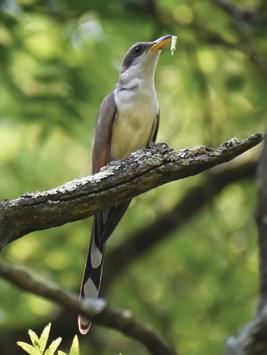
2 minute read
Birding in the Green Gables
Coral Gables Is A Magnet For Spring Migrants

BY JOSÉ FRANCISCO BARROS
Birdwatching has long been America’s No. 1 hobby, and over the past year it has proven an easy way to socially distance and enjoy nature. For Gables residents, birding in the field can be an everyday adventure. Indeed, “the field” is as close as the University of Miami campus, Matheson Hammock, Fairchild Tropical Botanic Garden or one of our 63 parks – not to mention the Biltmore, Granada and Riviera golf courses.
As winter gives way to spring, our snowbirds are already flying north. These colorful visitors – who, like our human tourists, sought South Florida’s temperate winter and abundant sunshine – are taking off from our backyards, traveling up a coastal route called the Atlantic Flyway. They are destined for places such as the Appalachians, Cape May, the Adirondacks, the Great Lakes, Cape Cod, even the Arctic, and they’re being joined by millions of migrants from the Caribbean and South America. Because peninsular Florida is eastern North America’s southernmost perch, it is the point of arrival for birds returning in spring from below the equator, island-hopping their way through the Caribbean. Coral Gables — with its expansive tree canopy — is an attractive stopover for rest and refueling. There is no better place to enjoy the miracle of Spring Migration than outside your door — be it your yard or a nearby City Beautiful green space. Many of the Gables’ 63 parks feature a healthy mix of native trees and shrubs that are bird magnets. The indigenous Gumbo Limbo, Live Oak and Strangler Fig make up the tree canopies in many of our parks; Firebush, Simpson Stopper and Wild Coffee frequently comprise their understories.
Birds and nature are my passion, so I birdwatch almost daily, and make frequent forays into various Coral Gables green spaces year-round. Country Club Prado – my “front yard” – takes pride of place. On my Sunday morning walks among its majestic trees I’m constantly scanning the branches for songbirds. At this time of year, I can count on seeing a variety of warblers here, and I’m watching for tightly knit flocks of Cedar Waxwings searching in unison for the ripe fruit of the Strangler Figs that grace the Prado.
If you golf at the Biltmore, Granada or Riviera courses, scan the skies for soaring raptors such continued on page 28

Bird with “Joe!”
José “Joe” Francisco Barros is a practicing endodontist and the president of Tropical Audubon Society. To go birding with him or other Tropical Audubon field guides (when MDC gathering restrictions permit), write to: fieldtrips@tropicalaudubon. org and your name will be added to the organization’s e-mail list.
as the American Kestrel, Osprey, Peregrine Falcon and Shorttailed Hawk. The oaks that anchor these courses also provide songbirds, such as the Blue-gray Gnatcatchers and charming warblers, with a sure supply of protein. They flit among the branches, gleaning insects from the leaves, nooks and crannies –food to power their northward journey. You can also keep an eye out for the arrival of some of our nesting residents, such as the Chimney Swifts, Gray Kingbirds and Swallow-tailed Kites.
Ingraham Park and Cartagena Plaza rim the Coral Gables Waterway at Le Jeune’s terminus. From the pedestrian bridge that spans the water you may see warblers and wading birds. Common Gallinules and Red-breasted Mergansers often swim along the shallows, while Great Blue Herons, Great Egrets and Green Herons fish from the shoreline.
Yellow-crowned Night-Herons can often be seen roosting or nesting in the trees that line the waterway.

Even in your neighborhood parks there is ample birding. In these quiet little green spaces you may spy a Yellow-bellied Sapsucker working the trunk of a Coconut Palm, pecking small openings, then patiently waiting for the insects who are drawn to the freshly tapped sap. If you are sharp and attentive, you may glimpse a Yellow-throated Vireo, or even a Yellow-billed Cuckoo, combing through the canopy for caterpillars to fuel their flight north. For locations and descriptions of parks visit coralgables. com and scroll down to “Community Recreation Parks and Open Spaces.” Then go buy a pair of 8x42 binoculars (the best can be found at the Leica store on Miracle Mile) and begin your Gables birding adventure. ■








